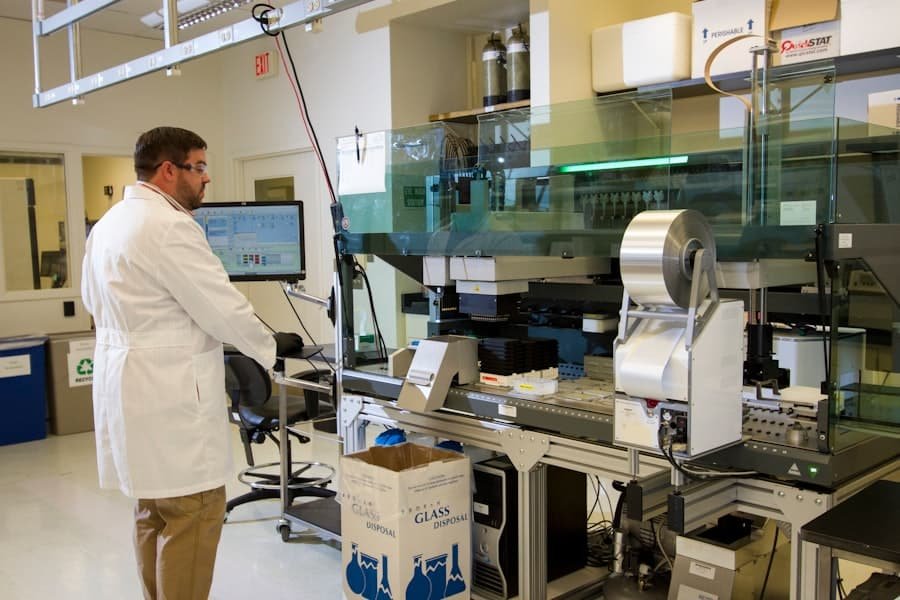Government funding for research and development (R&D) is a critical driver of innovation and technological progress. This financial support enables researchers to pursue high-risk, high-reward projects that may not attract private sector investment due to their uncertain outcomes. Such funding can lead to groundbreaking discoveries with the potential to revolutionize industries and enhance quality of life.
Government R&D funding also helps bridge the gap between basic research and commercialization. While basic research often forms the foundation for new technologies, it may take considerable time before these discoveries are market-ready. Government support can accelerate the development and commercialization process, bringing innovations to market more rapidly and efficiently.
Additionally, this funding can foster collaboration between academia, industry, and government agencies, promoting knowledge sharing and cross-sector partnerships. Critics of government R&D funding argue that it can be inefficient and susceptible to political influence. They contend that government agencies may not always make optimal investment decisions and that funding allocation may be influenced by political factors rather than scientific merit.
However, implementing robust oversight and accountability measures can help ensure that government R&D funding remains an effective tool for stimulating innovation and economic growth.
Key Takeaways
- Government funding is crucial for driving research and development in various industries.
- Collaboration between industry and academia can lead to innovative solutions and advancements in technology.
- Tax incentives can encourage companies to invest in innovation and drive economic growth.
- Intellectual property protection is essential for safeguarding the rights of innovators and creators.
- Access to a skilled workforce is vital for fostering innovation and driving technological advancements.
- Infrastructure and technology support are necessary for creating an environment conducive to innovation and growth.
- A supportive regulatory framework is essential for promoting innovation and ensuring the safety and efficacy of new technologies and products.
Collaboration between Industry and Academia
Knowledge Transfer and Expertise
One of the key benefits of industry-academia collaboration is that it allows for the transfer of knowledge and expertise between the two sectors. Academic researchers often have deep expertise in fundamental scientific principles and cutting-edge technologies, while industry partners bring practical experience and market insights. By working together, researchers from both sectors can leverage their respective strengths to tackle complex challenges and develop innovative solutions.
Aligning Research with Real-World Needs
Furthermore, industry-academia collaborations can also help to ensure that research efforts are aligned with real-world needs and market demands, increasing the likelihood of successful commercialization. This alignment can lead to the development of solutions that are more relevant and effective in addressing real-world problems.
Overcoming Challenges and Maximizing Value
However, industry-academia collaborations also present challenges, such as differences in culture, priorities, and timelines. Academic researchers may prioritize long-term scientific discovery, while industry partners may be more focused on short-term commercialization goals. Additionally, intellectual property rights and ownership can be a source of tension in collaborative partnerships. Despite these challenges, industry-academia collaborations have the potential to drive significant innovation and create value for both sectors.
Tax Incentives for Innovation

Tax incentives for innovation are a powerful tool for encouraging investment in R&D and driving technological advancement. By providing tax credits, deductions, or other incentives for R&D activities, governments can stimulate innovation, create jobs, and drive economic growth. These incentives can help to offset the high costs and risks associated with R&D efforts, making it more attractive for businesses to invest in innovation.
Additionally, tax incentives can also help to level the playing field for smaller companies and startups that may not have the same financial resources as larger corporations. Furthermore, tax incentives for innovation can also help to foster a culture of continuous improvement and technological advancement within businesses. By providing financial rewards for R&D activities, businesses are incentivized to invest in new technologies, processes, and products that have the potential to improve their competitiveness and drive growth.
This can lead to the development of new products and services that benefit consumers and drive economic development. On the other hand, some critics argue that tax incentives for innovation may not always be effective in achieving their intended goals. They argue that businesses may take advantage of these incentives without actually driving meaningful innovation or creating new value.
Additionally, there is also concern that tax incentives may disproportionately benefit larger corporations with greater financial resources, potentially exacerbating inequality in the business landscape. Despite these concerns, tax incentives for innovation remain a valuable tool for driving R&D investment and fostering technological advancement.
Intellectual Property Protection
Intellectual property protection is essential for incentivizing innovation and driving economic growth. By providing legal protections for inventions, designs, and creative works, intellectual property rights encourage investment in R&D activities by ensuring that innovators can reap the rewards of their efforts. This can take the form of patents for new inventions, trademarks for brand identity, copyrights for creative works, and trade secrets for proprietary information.
These protections give innovators the confidence to invest in R&D activities by providing them with exclusive rights to their creations. Furthermore, intellectual property protection also plays a crucial role in facilitating technology transfer and commercialization. By allowing innovators to license or sell their intellectual property rights to others, intellectual property protections enable the diffusion of new technologies and innovations across industries and markets.
This can lead to the development of new products and services that benefit consumers and drive economic development. However, there are also challenges associated with intellectual property protection, such as the potential for abuse or misuse of intellectual property rights. Critics argue that overly broad or restrictive intellectual property rights can stifle competition and hinder innovation by creating barriers to entry for new market entrants.
Additionally, there is also concern that intellectual property protections may disproportionately benefit larger corporations with greater financial resources, potentially exacerbating inequality in the business landscape. Despite these challenges, intellectual property protection remains a critical component of fostering innovation and driving economic growth.
Access to Skilled Workforce
Access to a skilled workforce is essential for driving innovation and technological advancement. Highly skilled workers with expertise in science, technology, engineering, and mathematics (STEM) fields are critical for conducting R&D activities, developing new technologies, and driving commercialization efforts. By investing in education and training programs that develop a pipeline of skilled workers, businesses and governments can ensure that they have the talent they need to drive innovation and remain competitive in a global marketplace.
One of the key benefits of access to a skilled workforce is that it enables businesses to pursue ambitious R&D projects and develop cutting-edge technologies. Skilled workers with expertise in specialized fields such as artificial intelligence, biotechnology, and advanced manufacturing are essential for pushing the boundaries of what is possible in terms of technological innovation. Additionally, access to a skilled workforce also enables businesses to adapt to rapidly changing market demands and technological advancements by leveraging the expertise of their employees.
However, there are also challenges associated with access to a skilled workforce, such as shortages of workers with specialized skills in certain industries or geographic regions. Additionally, there is also concern about disparities in access to education and training opportunities that may limit the diversity of the skilled workforce. Despite these challenges, access to a skilled workforce remains a critical factor in driving innovation and technological advancement.
Infrastructure and Technology Support

Enabling Ambitious R&D Projects
One of the key benefits of infrastructure and technology support is that it enables businesses to pursue ambitious R&D projects and develop cutting-edge technologies. Modern infrastructure provides businesses with the physical resources they need to conduct experiments, test prototypes, and develop new products. Additionally, technology support enables businesses to leverage advanced tools and equipment that can accelerate the pace of innovation and drive commercialization efforts.
Challenges in Infrastructure and Technology Support
However, there are also challenges associated with infrastructure and technology support, such as disparities in access to modern infrastructure in different geographic regions or industries. Additionally, there is also concern about the high costs associated with investing in modern infrastructure and technology support.
Overcoming Challenges to Drive Innovation
Despite these challenges, infrastructure and technology support remain critical factors in driving innovation and technological advancement.
Regulatory Framework for Innovation
A regulatory framework for innovation is essential for balancing the need to protect public health and safety with the need to foster technological advancement. Regulations play a crucial role in shaping the business environment by setting standards for product safety, environmental protection, data privacy, and other important considerations. A well-designed regulatory framework can provide businesses with clear guidelines for conducting R&D activities while ensuring that new technologies are developed responsibly.
One of the key benefits of a regulatory framework for innovation is that it provides businesses with certainty about what is required to bring new technologies to market. By establishing clear standards for product safety and performance, regulations can help to build consumer trust in new technologies while also providing businesses with a roadmap for navigating the commercialization process. Additionally, regulations can also help to ensure that businesses consider important ethical considerations when developing new technologies.
However, there are also challenges associated with regulatory frameworks for innovation, such as the potential for regulations to stifle innovation by creating barriers to entry or imposing excessive compliance costs on businesses. Additionally, there is also concern about disparities in regulatory standards across different geographic regions or industries that may create inefficiencies or hinder market access for new technologies. Despite these challenges, a well-designed regulatory framework remains essential for balancing the need to protect public health and safety with the need to foster technological advancement.
If you’re interested in learning more about how innovation and R&D are supported in developed economies, you should check out the article “The Importance of Research and Development in Economic Growth” on The Econosphere. This article delves into the crucial role that R&D plays in driving economic growth and how it is supported by various policies and initiatives in developed economies. It provides valuable insights into the ways in which governments and businesses collaborate to foster innovation and technological advancement.
FAQs
What are developed economies?
Developed economies are countries with high levels of income per capita, advanced technological infrastructure, and well-developed financial and industrial systems. These countries typically have high standards of living, strong institutions, and a high level of economic diversification.
How do developed economies support innovation and R&D?
Developed economies support innovation and R&D through various means, including government funding for research and development, tax incentives for businesses to invest in R&D, strong intellectual property protection, and collaboration between universities, research institutions, and private sector companies.
What role does government funding play in supporting innovation and R&D in developed economies?
Government funding plays a crucial role in supporting innovation and R&D in developed economies by providing financial support for basic and applied research, as well as for the development and commercialization of new technologies. This funding often comes in the form of grants, contracts, and subsidies for R&D activities.
How do tax incentives support innovation and R&D in developed economies?
Tax incentives, such as research and development tax credits, encourage businesses to invest in innovation and R&D by providing them with financial benefits for their R&D expenditures. These incentives help to lower the cost of R&D activities and stimulate greater investment in innovation.
What is the importance of intellectual property protection in supporting innovation and R&D in developed economies?
Intellectual property protection, including patents, trademarks, and copyrights, is important for incentivizing innovation and R&D in developed economies. Strong IP protection ensures that innovators and R&D investors can reap the rewards of their efforts, which in turn encourages further innovation and investment in R&D.
How does collaboration between universities, research institutions, and private sector companies contribute to innovation and R&D in developed economies?
Collaboration between universities, research institutions, and private sector companies facilitates the transfer of knowledge and technology, leading to the development of new products and processes. This collaboration also helps to ensure that R&D efforts are aligned with market needs and that new innovations are effectively commercialized.








